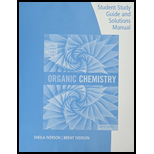
Concept explainers
(a)
Interpretation:
Reason for why
Concept Introduction:
According to the explanations by Bronsted-Lowry, if a species loses a proton then it is an acid whereas if a species receives one proton, then it is base.
If a base receives one proton, then the formed species is a conjugate acid whereas an acid lose one proton, then the formed species is a conjugated base.
Stronger the acid weaker it’s conjugate base and vice versa.
Deactivators are electron withdrawing groups attached to the benzenes that have either positive charge or an atom with high electronegativity. They are meta directors.
Activators are electron donating groups attached to the benzenes that have either electron density that is able to push into benzene ring or a lone pair of electrons. They are ortho–para directing.
(b)
Interpretation:
Reason for why the
Concept introduction:
According to the explanations by Bronsted-Lowry, if a species loses a proton then it is an acid whereas if a species receives one proton, then it is base.
If a base receives one proton, then the formed species is a conjugate acid whereas an acid lose one proton, then the formed species is a conjugated base.
Inductive effect: It is an electronic effect occurs due to the difference in the electronegativity of atoms in a bond. This unequal sharing of electrons in the bond leads to a permanent dipole.
Trending nowThis is a popular solution!

Chapter 23 Solutions
Student Study Guide and Solutions Manual for Brown/Iverson/Anslyn/Foote's Organic Chemistry, 8th Edition
- но HO но он The pK, of ascorbic acid (vitamin C) is 4.17, showing that it is slightly more acidic than acetic acid (CH3CO0H, pKa 4.74). (a) Show the fou r different conjugate bases that would be formed by deprotonation of the four different OH groups in ascorbic acid. (b) Compare the stabilities of these four conjugate bases, and predict which OH group of ascorbic acid is the most acidic. (c) Compare the most stable conjugate base of ascorbic acid with the conjugate base of acetic acid, and suggest why these two compounds have similar acidities, even though ascorbic acid lacks the carboxylic acid (COOH) group.arrow_forwardCarboxylic Acid Derivatives Resolve by synthesis, step by step.arrow_forwardExplain why CH3 CH2 CH2NH2 is a Brønsted base. Its water solutions are basic. All substances containing nitrogen atoms are Brønsted bases. This amine is a proton donor. This amine can ассеpt a proton from a proton donor.arrow_forward
- Compounds like amphetamine that contain nitrogen atoms are protonated by the HCl in the gastric juices of the stomach, and the resulting salt is then deprotonated in the basic environment of the intestines to regenerate the neutral form. Write proton transfer reactions for both of these processes. In which form will amphetamine pass through a cell membrane?arrow_forwardThe pKa of ascorbic acid (vitamin C, page 55) is 4.17, showing that it is slightly more acidic than acetic acid (CH3COOH, pKa 4.74). Compare the most stable conjugate base of ascorbic acid with the conjugate base of acetic acid, and suggest why these two compounds have similar acidities, even though ascorbic acid lacks the carboxylic acid (COOH) group.arrow_forwardBecause amines are basic, they can often accept a proton. Draw the protonated structure of n-propylamine.arrow_forward
- A naturally occurring amino acid such as alanine has a group that is a carboxylic acid and a group that is a protonated amine. The pKa values of the two groups are shown.(a). If the pKa value of a carboxylic acid such as acetic acid is about 5, then why is the pKa value of the carboxylic acid group of alanine so much lower? (b). Draw the structure of alanine in a solution at pH = 0. (c). Draw the structure of alanine in a solution at physiological pH (pH 7.4).(d). Draw the structure of alanine in a solution at pH = 12. (e). Is there a pH at which alanine is uncharged (that is, neither group has a charge)? (f) At what pH does alanine have no net charge (that is, the amount of negative charge is the same as the amount of positive charge)?arrow_forward(i) Draw the dissociation reaction for a carboxylic acid in water and define the Ka for this reaction. Write the equation that relates pKa to Ka. (ii) A deprotonated carboxylic acid can be drawn in two resonance forms. Draw the two forms and explain what the term “resonance” means. (iii) Draw an energy profile for the above dissociation reaction and describe how the profiles for a strong and a weak acid would differ.arrow_forwardThe pKa of ascorbic acid (vitamin C, page 55) is 4.17, showing that it is slightly more acidic than acetic acid (CH3COOH, pKa 4.74).Compare the stabilities of these four conjugate bases, and predict which OH group of ascorbic acid is the most acidicarrow_forward
 Organic ChemistryChemistryISBN:9781305580350Author:William H. Brown, Brent L. Iverson, Eric Anslyn, Christopher S. FootePublisher:Cengage Learning
Organic ChemistryChemistryISBN:9781305580350Author:William H. Brown, Brent L. Iverson, Eric Anslyn, Christopher S. FootePublisher:Cengage Learning Introduction to General, Organic and BiochemistryChemistryISBN:9781285869759Author:Frederick A. Bettelheim, William H. Brown, Mary K. Campbell, Shawn O. Farrell, Omar TorresPublisher:Cengage Learning
Introduction to General, Organic and BiochemistryChemistryISBN:9781285869759Author:Frederick A. Bettelheim, William H. Brown, Mary K. Campbell, Shawn O. Farrell, Omar TorresPublisher:Cengage Learning Macroscale and Microscale Organic ExperimentsChemistryISBN:9781305577190Author:Kenneth L. Williamson, Katherine M. MastersPublisher:Brooks Cole
Macroscale and Microscale Organic ExperimentsChemistryISBN:9781305577190Author:Kenneth L. Williamson, Katherine M. MastersPublisher:Brooks Cole



